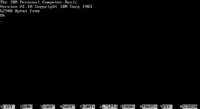- IBM BASICA
-
IBM BASICA 
Screen shot of IBM BASICA on an IBM PCAppeared in 1981 Developer Microsoft (for IBM) Influenced by IBM Cassette BASIC, IBM Disk BASIC Influenced GW-BASIC Platform IBM Personal Computer OS PC-DOS IBM BASICA (short for "Advanced BASIC") is a disk-based BASIC interpreter written by Microsoft for PC-DOS. BASICA used the ROM-resident code of "IBM Cassette BASIC" which was included with early models of IBM's PC. It added functions such as diskette file access, storing programs on disk, and monophonic music through the PC's built-in speaker. BASICA would not run on non-IBM computers (even so-called "100% compatible" machines) or later IBM models, since those lack the needed ROM BASIC.
Contents
Operation
BASICA was loaded when its name was typed at a DOS command prompt, with some optional parameters to control allocation of memory. When loaded, it displayed a sign-on identification message. The programmer could then enter in an entire program line by line, by entering the line number before the statement. Statements entered without a line number were executed in immediate mode. The function keys were assigned common commands, which were displayed at the bottom of the screen. Program source was stored internally in a compact tokenized form, where keywords were replaced with a single byte token, to save space and save execution time. Programs could be saved in tokenized form, or optionally saved as DOS text ASCII files that could be viewed and edited with other programs. Like most other MS-DOS/PC-DOS applications, BASICA was a text-mode program and had no features for windows, icons, mouse support, or cut and paste editing.
Versions
IBM personal computers came with several versions of BASIC. Cassette BASIC was built into the BIOS ROMs of the original PC and XT, and early models in the PS/2 line. It only supported a cassette tape interface for loading and saving programs, which was unavailable on models after the original 5150. Disk BASIC (BASIC.COM) added functions to use files on diskette, and also supported the serial port. It made use of the cassette BASIC ROM software and so would not run on machines not equipped with the IBM ROMs. Advanced BASIC (BASICA.COM) provided event trapping, extended support for monophonic sound (using the PC's built-in speaker), and graphics functions to set and clear pixels, draw lines and circles, and set colors. Advanced BASIC also required the casssette ROMs to function. A cartridge version of BASIC was only available on the IBM PCjr and supported the additional graphics modes and sounds possible on that platform.[1]
GW-BASIC was a Microsoft product distributed with non-IBM MS DOS computers, and supported all the graphics modes and features of BASICA on computers that did not have the IBM cassette BASIC.
The successor to BASICA for MS-DOS and PC-DOS versions was QBasic, which was a stripped-down version of the Microsoft QuickBASIC compiler that could not save executable files.
References
- ^ Readers' Feedback: IBM BASIC Versions, Computer! Magazine, No. 78, November 1986 p. 8
External links
Categories:- BASIC programming language family
- BASIC interpreters
- Discontinued Microsoft BASICs
- IBM personal computers
- IBM software
- Programming languages created in the 1980s
Wikimedia Foundation. 2010.
